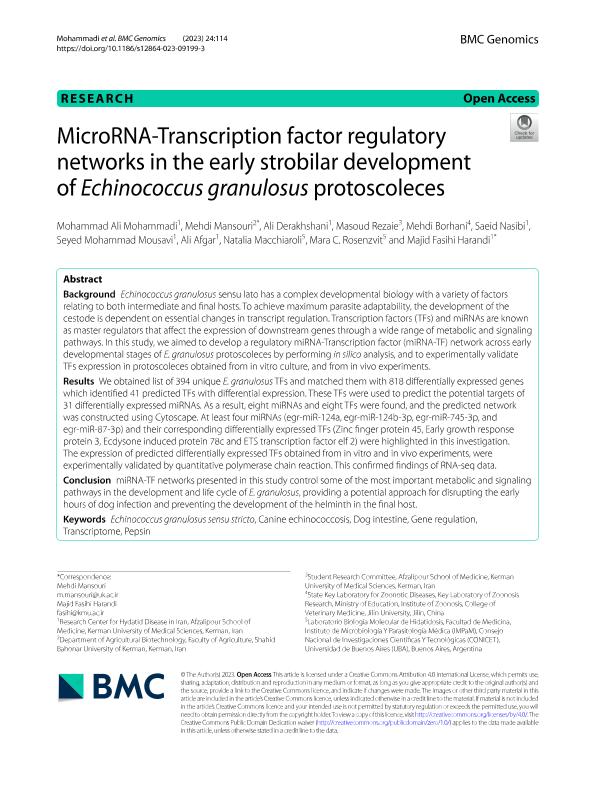Artículo
MicroRNA-Transcription factor regulatory networks in the early strobilar development of Echinococcus granulosus protoscoleces
Mohammadi, Mohammad Ali; Mansouri, Mehdi; Derakhshani, Ali; Rezaie, Masoud; Borhani, Mehdi; Nasibi, Saeid; Mousavi, Seyed Mohammad; Afgar, Ali; Macchiaroli, Natalia ; Rosenzvit, Mara Cecilia
; Rosenzvit, Mara Cecilia ; Harandi, Majid Fasihi
; Harandi, Majid Fasihi
 ; Rosenzvit, Mara Cecilia
; Rosenzvit, Mara Cecilia ; Harandi, Majid Fasihi
; Harandi, Majid Fasihi
Fecha de publicación:
03/2023
Editorial:
BioMed Central
Revista:
BMC Genomics
ISSN:
1471-2164
Idioma:
Inglés
Tipo de recurso:
Artículo publicado
Clasificación temática:
Resumen
Background: Echinococcus granulosus sensu lato has a complex developmental biology with a variety of factors relating to both intermediate and final hosts. To achieve maximum parasite adaptability, the development of the cestode is dependent on essential changes in transcript regulation. Transcription factors (TFs) and miRNAs are known as master regulators that affect the expression of downstream genes through a wide range of metabolic and signaling pathways. In this study, we aimed to develop a regulatory miRNA-Transcription factor (miRNA-TF) network across early developmental stages of E. granulosus protoscoleces by performing in silico analysis, and to experimentally validate TFs expression in protoscoleces obtained from in vitro culture, and from in vivo experiments. Results: We obtained list of 394 unique E. granulosus TFs and matched them with 818 differentially expressed genes which identified 41 predicted TFs with differential expression. These TFs were used to predict the potential targets of 31 differentially expressed miRNAs. As a result, eight miRNAs and eight TFs were found, and the predicted network was constructed using Cytoscape. At least four miRNAs (egr-miR-124a, egr-miR-124b-3p, egr-miR-745-3p, and egr-miR-87-3p) and their corresponding differentially expressed TFs (Zinc finger protein 45, Early growth response protein 3, Ecdysone induced protein 78c and ETS transcription factor elf 2) were highlighted in this investigation. The expression of predicted differentially expressed TFs obtained from in vitro and in vivo experiments, were experimentally validated by quantitative polymerase chain reaction. This confirmed findings of RNA-seq data. Conclusion: miRNA-TF networks presented in this study control some of the most important metabolic and signaling pathways in the development and life cycle of E. granulosus, providing a potential approach for disrupting the early hours of dog infection and preventing the development of the helminth in the final host.
Archivos asociados
Licencia
Identificadores
Colecciones
Articulos(IMPAM)
Articulos de INSTITUTO DE INVESTIGACIONES EN MICROBIOLOGIA Y PARASITOLOGIA MEDICA
Articulos de INSTITUTO DE INVESTIGACIONES EN MICROBIOLOGIA Y PARASITOLOGIA MEDICA
Citación
Mohammadi, Mohammad Ali; Mansouri, Mehdi; Derakhshani, Ali; Rezaie, Masoud; Borhani, Mehdi; et al.; MicroRNA-Transcription factor regulatory networks in the early strobilar development of Echinococcus granulosus protoscoleces; BioMed Central; BMC Genomics; 24; 1; 3-2023; 1-13
Compartir
Altmétricas



